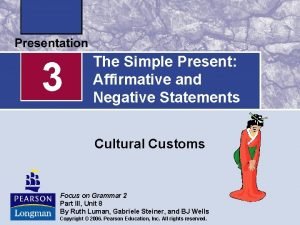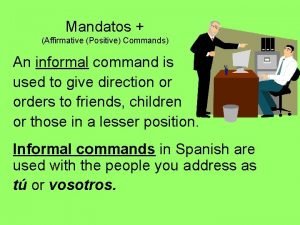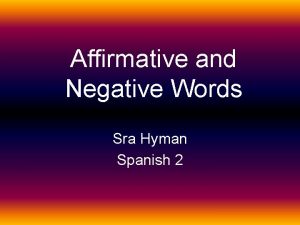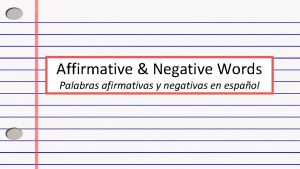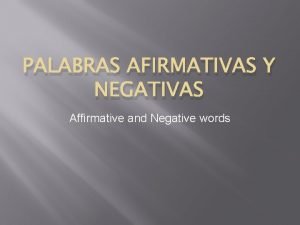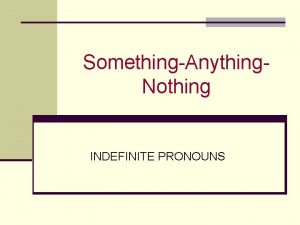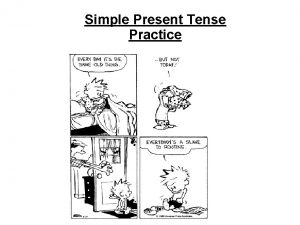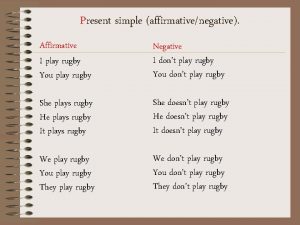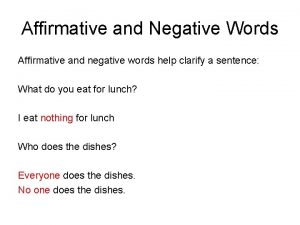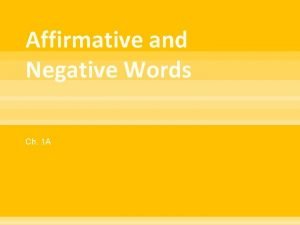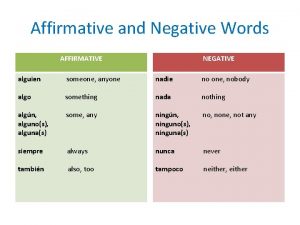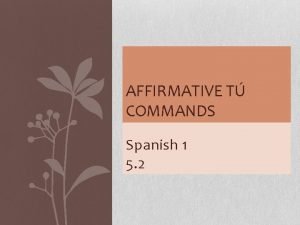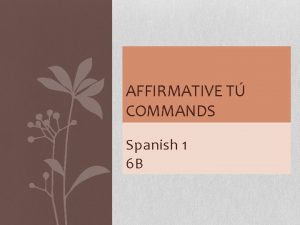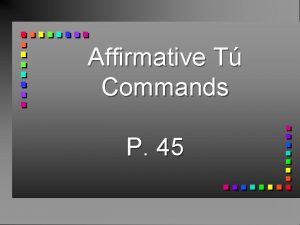AffirmativeNegative words AffirmativeNegative words AffirmativeNegative words Affirmative positive




















- Slides: 20

Affirmative/Negative words

Affirmative/Negative words

Affirmative/Negative words • Affirmative = positive

Affirmative/Negative words • Affirmative = positive • Negative = um, negative

Affirmative/Negative words • Affirmative = positive • Negative = um, negative Here is the trouble with these words:

Affirmative/Negative words • Affirmative = positive • Negative = um, negative Here is the trouble with these words: 1. Students have trouble with abstract words —they’re not visual

Affirmative/Negative words • Affirmative = positive • Negative = um, negative Here is the trouble with these words: 1. Students have trouble with abstract words—not visual 2. You can’t just go by translation, you need context:

Affirmative/Negative words • Affirmative = positive • Negative = um, negative Here is the trouble with these words: 1. Students have trouble with abstract words—not visual 2. You can’t just go by translation, you need context: ningún can be translated as “no”, or “neither” but is not interchangeable with “no” or “ni” or “tampoco”

Affirmative/Negative words • Affirmative = positive • Negative = um, negative Here is the trouble with these words: 1. Students have trouble with abstract words—not visual 2. You can’t just go by translation, you need context: ningún can be translated as “no”, or “neither” but is not interchangeable with “no” or “ni” or “tampoco” 3. These words translate words that we often leave out in English:

Affirmative/Negative words • Affirmative = positive • Negative = um, negative Here is the trouble with these words: 1. Students have trouble with abstract words—not visual 2. You can’t just go by translation, you need context: ningún can be translated as “no”, or “neither” but is not interchangeable with “no” or “ni” or “tampoco” 3. These words translate words that we often leave out: Ni estaba casado, ni tenía novia.

Affirmative/Negative words • Affirmative = positive • Negative = um, negative Here is the trouble with these words: 1. Students have trouble with abstract words—not visual 2. You can’t just go by translation, you need context: ningún can be translated as “no”, or “neither” but is not interchangeable with “no” or “ni” or “tampoco” 3. These words translate words that we often leave out: Ni estaba casado, ni tenía novia. 4. Spanish uses double negatives:

Affirmative/Negative words • Affirmative = positive • Negative = um, negative Here is the trouble with these words: 1. Students have trouble with abstract words—not visual 2. You can’t just go by translation, you need context: ningún can be translated as “no”, or “neither” but is not interchangeable with “no” or “ni” or “tampoco” 3. These words translate words that we often leave out: Ni estaba casado, ni tenía novia. 4. Spanish uses double negatives: No veo a nadie would be translated as “I don’t see anybody”, but really means “I don’t see nobody”—the double negative is correct in Spanish!

Affirmative/Negative words • Affirmative = positive • Negative = um, negative Here is the trouble with these words: 1. Students have trouble with abstract words—not visual 2. You can’t just go by translation, you need context: ningún can be translated as “no”, or “neither” but is not interchangeable with “no” or “ni” or “tampoco” 3. These words translate words that we often leave out: Ni estaba casado, ni tenía novia. 4. Spanish uses double negatives: No veo a nadie would be translated as “I don’t see anybody”, but really means “I don’t see nobody”—double negative is correct in Spanish! 5. Things that don’t exist are singular, not plural, in Spanish: “I don’t see any exits. ”

Affirmative/Negative words • Affirmative = positive • Negative = um, negative Here is the trouble with these words: 1. Students have trouble with abstract words—not visual 2. You can’t just go by translation, you need context: ningún can be translated as “no”, or “neither” but is not interchangeable with “no” or “ni” or “tampoco” 3. These words translate words that we often leave out: Ni estaba casado, ni tenía novia. 4. Spanish uses double negatives: No veo a nadie would be translated as “I don’t see anybody”, but really means “I don’t see nobody”—double negative is correct in Spanish! 5. Things that don’t exist are singular, not plural, in Spanish: “I don’t see any exits. ” (If they’re not there, why are they plural? )

Affirmative/Negative words • Affirmative = positive • Negative = um, negative Here is the trouble with these words: 1. Students have trouble with abstract words—not visual 2. You can’t just go by translation, you need context: ningún can be translated as “no”, or “neither” but is not interchangeable with “no” or “ni” or “tampoco” 3. These words translate words that we often leave out: Ni estaba casado, ni tenía novia. 4. Spanish uses double negatives: No veo a nadie would be translated as “I don’t see anybody”, but really means “I don’t see nobody”—double negative is correct in Spanish! 5. Things that don’t exist are singular, not plural, in Spanish: “I don’t see any exits. ” (If they’re not there, why are they plural? ) In Spanish, they’re singular:

Affirmative/Negative words • Affirmative = positive • Negative = um, negative Here is the trouble with these words: 1. Students have trouble with abstract words—not visual 2. You can’t just go by translation, you need context: ningún can be translated as “no”, or “neither” but is not interchangeable with “no” or “ni” or “tampoco” 3. These words translate words that we often leave out: Ni estaba casado, ni tenía novia. 4. Spanish uses double negatives: No veo a nadie would be translated as “I don’t see anybody”, but really means “I don’t see nobody”—double negative is correct in Spanish! 5. Things that don’t exist are singular, not plural, in Spanish: “I don’t see any exits. ” (If they’re not there, why are they plural? ) In Spanish, they’re singular: No veo ninguna salida.

Affirmative/Negative words • Affirmative = positive • Negative = um, negative Here is the trouble with these words: 1. Students have trouble with abstract words—not visual 2. You can’t just go by translation, you need context: ningún can be translated as “no”, or “neither” but is not interchangeable with “no” or “ni” or “tampoco” 3. These words translate words that we often leave out: Ni estaba casado, ni tenía novia. 4. Spanish uses double negatives: No veo a nadie would be translated as “I don’t see anybody”, but really means “I don’t see nobody”—double negative is correct in Spanish! 5. Things that don’t exist are singular, not plural, in Spanish: “I don’t see any exits. ” In Spanish, they’re singular: No veo ninguna salida. 6. We’ll be using “some” as a singular, as in: “some guy told me”, “I’ll see you some day”.

Affirmative/Negative words Here is the trouble with these words: 1. Students have trouble with abstract words—not visual 2. You can’t just go by translation, you need context: ningún can be translated as “no”, or “neither” but is not interchangeable with “no” or “ni” or “tampoco” 3. These words translate words that we often leave out: Ni estaba casado, ni tenía novia. 4. Spanish uses double negatives: No veo a nadie would be translated as “I don’t see anybody”, but really means “I don’t see nobody”—double negative is correct in Spanish! 5. Things that don’t exist are singular, not plural, in Spanish: “I don’t see any exits. ” In Spanish, they’re singular: No veo ninguna salida. 6. We’ll be using “some” as a singular, as in: “some guy told me”, “I’ll see you some time”. ¿Hay alguna pregunta?

Affirmative/Negative words Here is the trouble with these words: 1. Students have trouble with abstract words—not visual 2. You can’t just go by translation, you need context: ningún can be translated as “no”, or “neither” but is not interchangeable with “no” or “ni” or “tampoco” 3. These words translate words that we often leave out: Ni estaba casado, ni tenía novia. 4. Spanish uses double negatives: No veo a nadie would be translated as “I don’t see anybody”, but really means “I don’t see nobody”—double negative is correct in Spanish! 5. Things that don’t exist are singular, not plural, in Spanish: “I don’t see any exits. ” In Spanish, they’re singular: No veo ninguna salida. 6. We’ll be using “some” as a singular, as in: “some guy told me”, “I’ll see you some time”. ¿Hay alguna pregunta? Vamos a comer en algún restaurante.

Affirmative/Negative words Here is the trouble with these words: 1. Students have trouble with abstract words—not visual 2. You can’t just go by translation, you need context: ningún can be translated as “no”, or “neither” but is not interchangeable with “no” or “ni” or “tampoco” 3. These words translate words that we often leave out: Ni estaba casado, ni tenía novia. 4. Spanish uses double negatives: No veo a nadie would be translated as “I don’t see anybody”, but really means “I don’t see nobody”—double negative is correct in Spanish! 5. Things that don’t exist are singular, not plural, in Spanish: “I don’t see any exits. ” In Spanish, they’re singular: No veo ninguna salida. 6. We’ll be using “some” as a singular, as in: “some guy told me”, “I’ll see you some time”. ¿Hay alguna pregunta? Vamos a comer en algún restaurante.
 To do affirmative form
To do affirmative form Affirmative command
Affirmative command Agree what must be positive or negative
Agree what must be positive or negative Gram positive catalase positive cocci
Gram positive catalase positive cocci Positive + positive equals
Positive + positive equals Positive practice positive outcomes
Positive practice positive outcomes Spanish affirmative and negative words
Spanish affirmative and negative words Negative to affirmative sentence
Negative to affirmative sentence Affirmative words
Affirmative words Negative and indefinite words spanish practice
Negative and indefinite words spanish practice Affirmative and negative words
Affirmative and negative words Negative affirmative and indefinite expressions spanish
Negative affirmative and indefinite expressions spanish Affirmative and negative statements
Affirmative and negative statements Positive words safewards
Positive words safewards Although in the middle of the sentence
Although in the middle of the sentence Talk down safewards
Talk down safewards Past progressive affirmative
Past progressive affirmative Indefinite pronouns examples in sentences
Indefinite pronouns examples in sentences Non possessory interest
Non possessory interest Simple present tense sentences affirmative
Simple present tense sentences affirmative Realidades 2 irregular affirmative tu commands
Realidades 2 irregular affirmative tu commands
